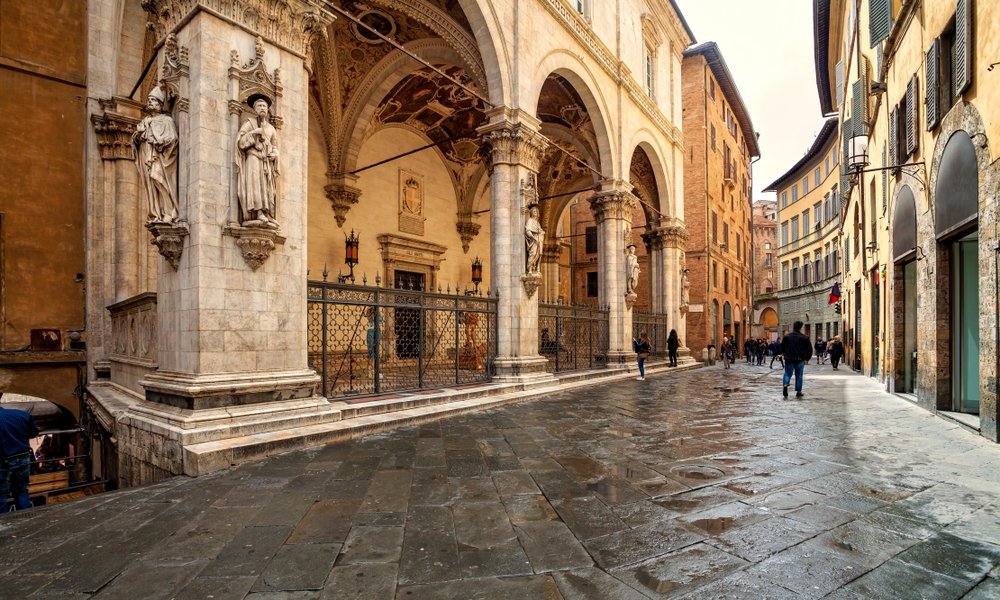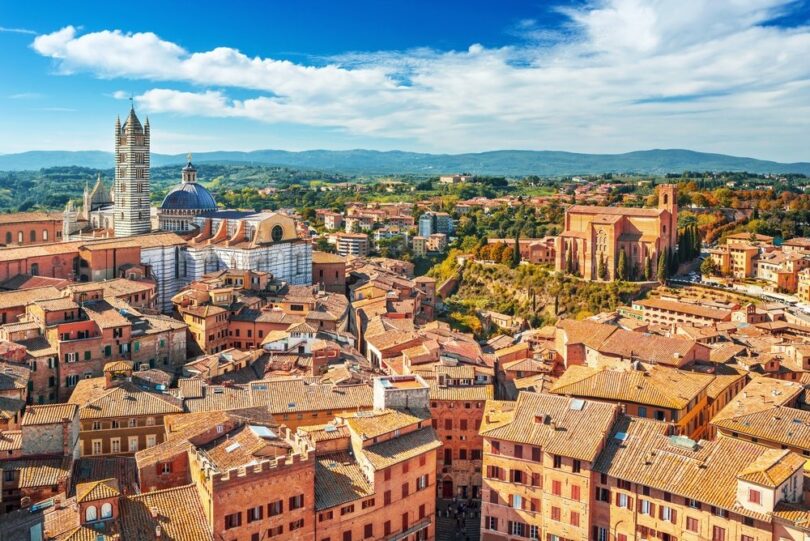Özge Şengelen
Nestled in the heart of Tuscany, the medieval castle city of Siena transports you to the 13th century with its narrow, labyrinthine streets and thriving, unique neighborhood culture
When you think of Italy, which cities come to mind? Rome, Florence, or Milan … For instance, when you think of France, you think of Paris, or when you think of the Netherlands, you think of Amsterdam – in my opinion, there isn’t just one specific city that comes to mind when you think of Italy. To me, Italy means dozens of beautiful cities and towns from north to south, each with its own charm. Especially the small medieval towns in Italy’s Tuscany region make me feel like flowers are blooming inside me.
Siena is one of those towns that can make you feel like a character from the movie “Under the Tuscan Sun” as you journey with the vineyards and natural landscapes accompanying you.
With its dominant shades of red, yellow and brown, the town makes you feel like you’re on a film set while also transporting you back to the Middle Ages. Although Siena has become known for its unique neighborhood culture and the Palio horse races, it has also captured my heart with its historical fabric. In the historic area surrounded by castle walls where cars are not allowed, you will be enchanted as you wander through the labyrinthine narrow streets. Despite being empty for 200 years due to a plague outbreak, the city has maintained its historical charm. You can understand this from the buildings you see while wandering its streets. Moreover, you’ll feel how much the people living here are attached to their traditions and the land they were born and raised in.
Siena has an impressive neighborhood culture rooted in tradition. There are 17 neighborhoods in Siena that have names based on animals and colors. Walking through the streets, you can quickly determine which neighborhood you’re in based on the symbols you see on the buildings. The residents of these 17 neighborhoods, with names like Panther Neighborhood, Lion Neighborhood, Turtle Neighborhood, Snail Neighborhood and Dragon Neighborhood, love and take ownership of their streets like supporting a sports team. In fact, in this tradition dating back to the Middle Ages, there is also competition between the neighborhoods. For example, if two people from different neighborhoods are going to get married, contracts are made about which neighborhood their children will belong to after birth.

There’s another tradition where this competition is fierce, making the concept of neighborhood even more important. This tradition takes place twice a year in the Palio horse races, lasting only 90 seconds, where the neighborhoods compete. These races, held in Piazza Del Campo square, attract thousands of spectators, both locals and foreigners.
Piazza del Campo
Although Piazza del Campo Square is known for hosting important horse races in Siena, it also caught my attention with its unique details. Divided into nine sections resembling slices of pizza, this square, built in the 13th century, represents the Rule of Nine that governed Siena during the Middle Ages. The square has a sloped design to provide a better view of the races, and the balconies of the houses serve as grandstands.
I believe Piazza del Campo is the ideal place to start exploring Siena, and it’s considered one of the best medieval squares. The square is home to historical buildings such as Torre del Mangia, Palazzo Pubblico and Fonte Gaia, as well as charming restaurants and cafes. It can be said that Piazza del Campo is the heart of Siena. I don’t remember how often I turned around in the middle of the square. With each turn, I thought it was one of the most enchanting squares in Europe.
Palazzo Pubblico
While spinning around and examining the square, the building I spent the most time in front of in Piazza Del Campo was Palazzo Pubblico. Its grand architecture and tower come to my mind even as I write this sentence. It fascinated me so much that while watching it, I imagined medieval knights drawing their swords from the arched windows on the façade. Observing structures in the cities I visit, getting lost in the moment and immersing myself in the history of the place allows me to truly enjoy traveling.
Torre del Mangia
Built in the 13th century with Italian gothic architecture, Palazzo Pubblico serves as the city hall today, and its magnificent architecture is complemented by Torre del Mangia, a 102-meter (335-foot) tower. This tower, the second tallest in Italy during the Middle Ages, stands out prominently. By climbing to the observation point of Torre del Mangia, you can witness the splendid panorama of Tuscany. Although you must climb 200 steps to reach the top, it’s worth it.

Fonte Gaia
Located in Piazza del Campo, this fountain, known as the Fountain of Joy, was built in 1342. The fountain, made in memory of the late arrival of water to Siena, takes its name from Greek mythology. Fonte Gaia Fountain, like other structures in Siena, boasts gothic architecture and is a must-see in the city.
Siena Duomo
Among all the cathedrals and religious structures I’ve seen in Europe, Siena Duomo was one of the few places that truly enchanted and imprinted itself in my memory. Its present-day magnificent appearance owes much to the decorations by Giovanni Pisano, turning the cathedral into a work of art in itself.
Located right in the city center, the cathedral, which represents one of the finest examples of Italian Gothic architecture, is also known as Siena Duomo. Despite not reaching its original planned size, expected to be even larger than the Vatican, due to a plague outbreak and financial limitations in the 14th century, the cathedral is still magnificent. Throughout history, the cathedral has undergone numerous restorations and additions, and you can see valuable works by world-renowned artists such as Donatello and Bernini.
Among the cities that I can’t forget from my eight-day journey in Italy, Siena is one that I wish I could have spent more time in to truly experience its spirit. In my opinion, Siena is a place where you can immerse yourself in its unique neighborhood culture and preserved traditions. So, for those who have been to Siena once, it should definitely be on the list for a second visit, and for those who haven’t been yet, it’s a must-add destination.
Courtesy: Dailysabah







